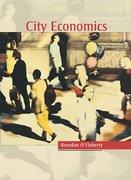Consider a circular, monocentric city with 500,000 low-income consumers and 200,000 high-income consumers, each of whom has
Question:
Consider a circular, monocentric city with 500,000 low-income consumers and 200,000 high-income consumers, each of whom has a completely fixed demand for land of 2787.84 square feet (one ten-thousandth of a square mile). High-income consumers have greater transportation costs per mile:
$500 per mile per year, as opposed to $250 per mile per year for low-income consumers. Assume rural land rents are zero. Which income group lives closer to the city center? Why? Draw the rent gradient.What happens to the rent gradient if transportation costs for the rich decrease to $400 per mile per year but transportation costs for the poor stay the same?
Step by Step Answer:
Related Book For 

Question Posted:





